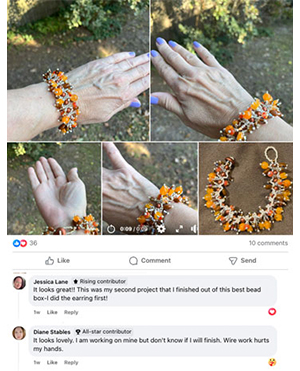- Jewelry-Making Supplies ▾
Design Jewelry with Confidence!
Seed Beads
Thread, Wire, & Stringing Materials
Athenacast Findings & Components
Everything Else
- Kits & Collections ▾
Assemble Your World
Kits & Collections
- Subscriptions ▾
Want monthly Beading Happiness?
Subscriptions
- Learn to Make ▾
Want to learn more?
- Discounts & Deals ▾
Explore Today's Promotions!
- Jewelry-Making Supplies
- Kits & Collections
- Subscriptions
- Learn to Make
- Discounts & Deals
-
Seed Beads
Thread, Wire, & Stringing Materials
Findings & Components
Everything Else
-
Kits & Collections
-
Subscriptions
- Home
- How to Make Jewelry
- Better Beader Episodes
- Helpful Hints: The Thread in Your …
Helpful Hints: The Thread in Your Needle

Watch the Video Tutorial
Watch the Video Tutorial
Need Any Extra Materials?
Need Any Extra Materials?
Need Any Extra Materials?
Need Any Extra Materials?
Episode Transcript
Episode Transcript
Introduction
In this episode of Better Beader, the talented hosts from Potomac Beads share their expert tips and techniques for working with thread and needles in jewelry making. Whether you're a beginner or an experienced beader, mastering the art of threading your needle and choosing the right materials can make all the difference in your projects. Join us as we dive into this informative tutorial and discover helpful hints to elevate your beading skills.
Materials Needed
- Beading thread (e.g., Fireline, Wildfire, or K.O. Thread)
- Beading needles (size 10 or 12 recommended)
- Thread conditioner (optional)
- Scissors or thread cutters
- Beading mat or work surface
Step-by-Step Tutorial
- Choose the right thread for your project
- Consider the size and type of beads you'll be using
- Opt for a strong, durable thread like Fireline or Wildfire for projects with heavy beads or sharp edges
- Use a more flexible thread like K.O. Thread for projects with delicate beads or intricate weaving
- Condition your thread (optional)
- Apply a small amount of thread conditioner to reduce fraying and improve manageability
- Run the thread through the conditioner a few times, then allow it to air dry before use
- Thread your needle
- Cut a length of thread appropriate for your project (usually around 4-6 feet)
- Flatten one end of the thread between your fingers to create a point
- Insert the flattened end through the eye of the needle
- Pull the thread through until you have equal lengths on both sides of the needle
- Secure your thread
- Tie a knot at the end of your thread to prevent beads from slipping off
- Leave a short tail (about 6 inches) for weaving in later
- Begin beading your project
- Follow your pattern or design, adding beads to the thread as you go
- Keep your tension consistent throughout the project to ensure even spacing and shape
- Ending and weaving in your thread
- When you have about 6 inches of thread left, it's time to end your thread
- Weave the remaining thread back through several beads to secure it
- Trim the excess thread close to the beadwork, ensuring the knot is hidden
Customization Ideas & Inspiration
Now that you've mastered the basics of working with thread and needles, it's time to get creative! Experiment with different thread colors to add a pop of contrast or blend seamlessly with your beads. Try using multiple strands of thread for a more substantial look, or mix and match thread types for unique textures and effects.
Remember, the key to success is practice and patience. Don't be discouraged if your first attempts aren't perfect – every mistake is an opportunity to learn and improve your skills.
Conclusion
We hope this tutorial has provided you with valuable insights and helpful hints for working with thread and needles in your beading projects. By choosing the right materials, mastering basic techniques, and staying creative, you'll be well on your way to creating stunning, professional-quality jewelry.
If you enjoyed this tutorial, be sure to check out our other Better Beader episodes for more expert tips, techniques, and project ideas. Happy beading!
Join Our Growing Community
Join Our Growing Community




Our Testimonials
Our Testimonials
- 56303 (83.6%)
- 4846 (11.2%)
- 3320 (4.2%)
- 237 (0.5%)
- 129 (0.4%)
- Favorite Reviews
- Highest to Lowest
- Newest to Oldest
- All Ratings
- 5 ★ Reviews
- 4 ★ Reviews
- 3 ★ Reviews
- 2 ★ Reviews
- 1 ★ Reviews
Hi Allie, I've purchased today's special deal (blue pearl kit) but I was charged shipping even though I clicked on the "Get Free Shipping" button, and I also ordered from the live sale site and paid shipping there also, even though my order was over $30. PLEASE HELLLLLPP!!!
Glad you have the thread burner back in stock I am enjoying learning to bead and love monthly kits. Thanks for being there to help me on utube I've made mistakes but I work myself backwards until I get to the booboo. Today it looked like a spider but I didn't stop going back through. Oh my, it is a challenge I look forward to tackling, and a new hobby as well. Thanks Allie!!
Loading...
Only Visible on Admin Mode
Item Description
Designer's Material List
Project Steps
Threading the Needle: Thread your needle, ensuring the thread is positioned in the center of the needle's eye to prevent stripping.
Maintain Thread Position: As you bead, frequently adjust the thread's position in the needle to distribute wear evenly and prevent the thread from weakening at a single point.
Monitoring Thread Health: Keep an eye on your thread for any signs of fraying or wear, especially near the eye of the needle, and adjust as necessary.
Highest Quality
Products
100% Money
Back Guarantee
Fast
Shipping
Best Teaching &
Customer Service
You'll want these emails...
Get Free Projects & Inspiration
Get Free Projects & Inspiration
- Bullet 1
- Bullet 2
- Bullet 3
Copyright © PotomacBeads









